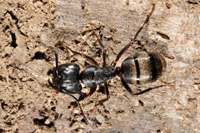
Common Name: Carpenter ant
Scientific Name: Formicidae: several species
Status: usually beneficial, occasionally a pest of homes and buildings
Damaging Stage: adult
Biology: Carpenter ants range in size from � to � inch, depending on whether the insect is a queen or a worker. Queens are large and black with some red, brown, or yellow spots occurring on parts of the body and legs. The smaller workers are brown and have a large head and a small thorax. Ant larvae are legless and grublike. They are approximately � inch long and cream colored.
The queen establishes a nesting site in a wood cavity. Each stage of the life cycle (egg, larval, pupal) takes approximately three weeks to complete, but cool weather can lengthen these periods. The queen rears her first brood of workers, feeding them salivary secretions. The workers then take on the maintenance, rearing and foraging duties of the colony.
 Injury: Most carpenter ants are beneficial insects. Outdoors they may offer plant protection by consuming potential pest insects, and they also facilitate the breakdown of dead trees on a forest floor. Carpenter ants do not eat wood but they often nest in moist wood, including rotting trees, tree roots, tree stumps, and logs or boards lying on or buried in the ground. They can also nest in moist or decayed wood inside buildings. Nests have been found behind bathroom tiles, around tubs, under roofing, in attic beams, and under subfloor insulation. The ants may cause damage to structures when they nest in or hollow out wood boards for shelter.
 Action Threshold: Presence of adults may not be a good indicator of an infestation because ants are known to forage quite widely. If piles of sawdust are found in an area of high ant activity, it is likely that the ants are nesting close by. Nesting also may be a good indicator that a water problem exists or has existed in recent times. In cases of severe infestation, a professional consultant should be called to treat the building.
Management: Chemical controls are usually the best option for a carpenter ant infestation inside a building when the nest can be located. Ant baits are effective when properly used to control foraging ants.
|